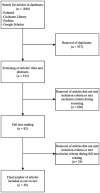Environmental factors of obesity before and after COVID-19 pandemic: a review
- PMID: 38186688
- PMCID: PMC10766782
- DOI: 10.3389/fpubh.2023.1213033
Environmental factors of obesity before and after COVID-19 pandemic: a review
Abstract
In past decades the prevalence of overweight and obesity had grown rapidly. There are numerous factors contributing to this unfavorable change in people's health. This review article investigates the environmental factors which may play a role in the prevalence of overweight and obesity and additionally the novel factors which appeared after the beginning of the COVID-19 pandemic, which caused the increase in BMI during the lockdown period. Most of the studies reveal that the COVID-19 pandemic and lockdown contributed to the growth of BMI in numerous countries and, eventually the prevalence of overweight and obesity increased. Studies suggest that the physical activity was decreased while sleep time and screen time were increased and the amount of food consumed increased, additionally more processed food with long shelf life was consumed. The diverse environmental factors may have an impact on obesity and overweight development taking into account policy and local school policy issues, socioeconomic status, lifestyle including physical activity, diet habits, and amongst others, more trivial causes such as uninteresting neighborhoods, lack of sense of security outside the place of residence or a long distance from shops. Still, this is the object of debate if air pollution is an environmental risk factor influencing the unfavorable trends towards increasing body weight.
Keywords: COVID-19 pandemic; eating habits; environmental factors; obesity; overweight; pollution.
Copyright © 2023 Wolińska, Kraik, Poręba, Gać and Poręba.
Conflict of interest statement
The authors declare that the research was conducted in the absence of any commercial or financial relationships that could be construed as a potential conflict of interest.
Figures
Similar articles
-
Sedentary Time and Fast-Food Consumption Associated With Weight Gain During COVID-19 Lockdown in Children and Adolescents With Overweight or Obesity.J Korean Med Sci. 2022 Mar 28;37(12):e103. doi: 10.3346/jkms.2022.37.e103. J Korean Med Sci. 2022. PMID: 35347907 Free PMC article.
-
The effectiveness of web-based programs on the reduction of childhood obesity in school-aged children: A systematic review.JBI Libr Syst Rev. 2012;10(42 Suppl):1-14. doi: 10.11124/jbisrir-2012-248. JBI Libr Syst Rev. 2012. PMID: 27820152
-
The Side-Effects of the COVID-19 Pandemic: Increased BMI z-Score in Children with Overweight and Obesity in a Personalised Lifestyle Intervention One Year after the Start of the Pandemic in The Netherlands.Nutrients. 2022 May 5;14(9):1942. doi: 10.3390/nu14091942. Nutrients. 2022. PMID: 35565909 Free PMC article.
-
COVID-19 pandemic: A review of the global lockdown and its far-reaching effects.Sci Prog. 2021 Apr-Jun;104(2):368504211019854. doi: 10.1177/00368504211019854. Sci Prog. 2021. PMID: 34061685 Free PMC article. Review.
-
Obesity and COVID-19: What are the Consequences?Horm Metab Res. 2022 Aug;54(8):496-502. doi: 10.1055/a-1878-9757. Epub 2022 Jun 20. Horm Metab Res. 2022. PMID: 35724688 Free PMC article. Review.
Cited by
-
Application of the health belief model to study weight management behavioral intentions among adults in Ho Chi Minh City, Vietnam: a cross-sectional study.BMC Public Health. 2025 Jul 11;25(1):2436. doi: 10.1186/s12889-025-23637-9. BMC Public Health. 2025. PMID: 40646482 Free PMC article.
-
Obesity Representations: An Analysis of Italian Newspapers' Coverage before and after COVID-19 and the Influence of Political Orientation.Obes Facts. 2025 Apr 10:1-16. doi: 10.1159/000542544. Online ahead of print. Obes Facts. 2025. PMID: 40209690 Free PMC article.
-
Facing stress and inflammation: From the cell to the planet.World J Exp Med. 2024 Dec 20;14(4):96422. doi: 10.5493/wjem.v14.i4.96422. eCollection 2024 Dec 20. World J Exp Med. 2024. PMID: 39713080 Free PMC article. Review.
References
-
- Mean BMI (kg/m2) (crude estimate) . WHO’s Global Health Observatory data (2017). WHO Global Health Estimates. Available at: https://www.who.int/data/gho/data/indicators/indicator-details/GHO/mean-...
Publication types
MeSH terms
LinkOut - more resources
Full Text Sources
Medical
Miscellaneous




